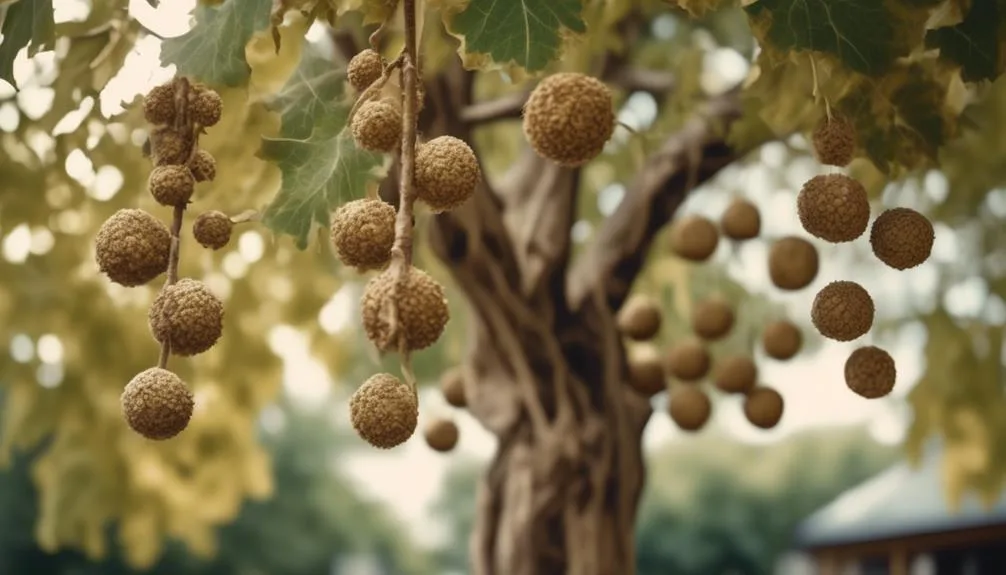Sycamore trees produce intriguing round seed balls that hang from their branches. These structures, also called 'buttonballs' or 'monkey balls,' play a crucial role in the tree's survival and its place in nature. Understanding the reasons behind their unique shape and formation sheds light on the sycamore tree's remarkable strategies.
What drives the sycamore tree to create these perfectly round and captivating seed balls? Exploring this mystery can reveal fascinating insights into the natural world.
Sycamore Trees and Seed Ball Formation
Sycamore trees produce intriguing round seed balls. These seed balls are formed through a fascinating natural process that captures the wonder of nature in action. The development of these seed balls is a testament to the intricate genetics of sycamore trees.
It all starts with the tree's flowers, which contain both male and female reproductive parts. When the flowers are pollinated, they form seeds encased in protective structures. These protective structures eventually develop into the round seed balls. This process is essential for the dispersal and propagation of sycamore trees.
The genetics at play ensure that the seed balls contain viable seeds and are well-equipped for distribution. As the seed balls mature, they become visually striking, adding to the allure of sycamore trees and their remarkable genetic processes.
Environmental Factors Influencing Seed Ball Shape
Under the influence of various environmental factors, the shape of sycamore seed balls undergoes a fascinating transformation, reflecting the intricate interplay between the genetic makeup of the tree and its surrounding conditions.
Climate influences such as temperature and humidity play a significant role in determining the shape of sycamore seed balls. In warmer, drier climates, the seed balls tend to be more spherical, while in cooler, moister climates, they may exhibit more irregular shapes.
This climate influence is closely tied to genetic variation within sycamore tree populations. Genetic variation can lead to differences in the thickness of the seed ball's outer layer, affecting its overall shape.
Therefore, the environmental conditions in which sycamore trees grow, along with their genetic diversity, contribute to the diverse shapes of sycamore seed balls found in nature.
Evolutionary Advantage of Round Seed Balls
With their spherical shape, sycamore seed balls provide an evolutionary advantage that has contributed to the tree's success in various environments. This unique trait has been honed by natural selection over time, giving sycamore trees a competitive edge in their reproductive strategy.
Consider the following:
- Efficient Dispersal: The round shape of the seed balls allows them to roll along the ground, aiding in their dispersal away from the parent tree.
- Enhanced Survival: By being distributed over a wider area, the seeds have a greater chance of finding suitable conditions for germination and growth.
Through the process of natural selection, sycamore trees have developed this reproductive strategy, ensuring the widespread dissemination and survival of their offspring, ultimately contributing to the species' continued success.
Seed Ball Dispersal and Germination
Efficient dispersal and successful germination are crucial factors in the reproductive strategy of sycamore trees, ensuring the widespread distribution and survival of their offspring.
Sycamore seed balls, with their unique morphology, play a pivotal role in the seed ball ecology. The spherical shape and light, yet sturdy, structure of the seed balls aid in dispersal.
As they dry, they become brittle, allowing them to break open easily and release the seeds. This facilitates their transport by wind, water, or animals to distant locations, increasing the chances of finding suitable germination sites.
Upon landing, the protective seed ball casing shields the seeds from predators and harsh environmental conditions, while the organic material of the seed ball itself contributes to the soil, creating a nurturing environment for germination.
This sophisticated method ensures that sycamore seeds have the best possible chance of successful germination and growth.
Human Uses of Sycamore Tree Seed Balls
Sycamore tree seed balls offer a variety of practical and creative uses for humans, adding both functional and aesthetic value to various activities and crafts. You can find many applications for these unique seed balls.
- Crafts: Use the seed balls in art projects to create natural and textured decorations.
- Decorations: String the seed balls together to make rustic garlands or ornaments.
- Landscaping and Gardening: Incorporate the seed balls into landscaping design or use them as natural mulch in your garden. Their unique shape and texture can add visual interest to your outdoor spaces.
Conclusion
In marveling at the round seed balls of sycamore trees, we witness nature's astute strategy for survival. These seed balls, a product of intricate evolution, confer the sycamore tree a competitive advantage in the natural world.
As we observe and appreciate these wonders, we're reminded of the endless adaptations and ingenuity found in the natural world. Keep exploring, and let nature's brilliance inspire your journey.

My interest in trees started when I first saw the giant sequoias in Yosemite.
I was a teenager then, and I remember thinking, “I need to learn more about this.”
That moment stuck with me.
A few years later, I went on to study forestry at Michigan Tech.
Since graduating, I’ve worked in a mix of hands-on tree care and community education.
I’ve spent over ten years helping people understand how to plant, maintain, and protect the trees in their neighborhoods.
I don’t see trees as just part of the landscape.
They are living things that make a real difference in our daily lives.
